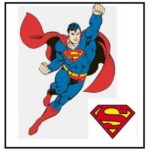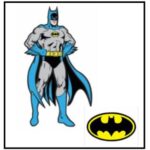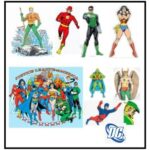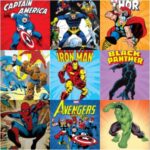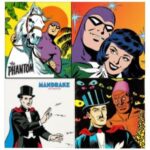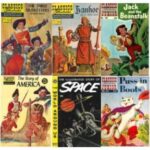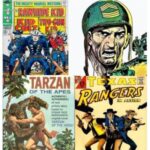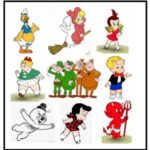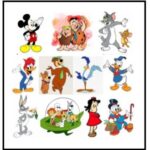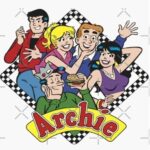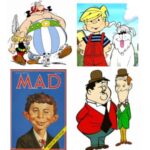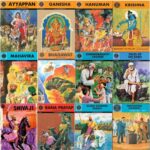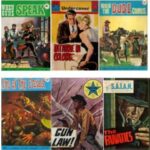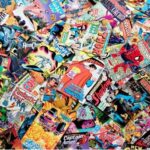Clicking on the following links or images will take you to the pages covering the various classifications of the comics listed on this site:
Note: Click here to go to the Blogs, Posts & Forum section on comics.
Comic books engender a passion among fans like no other form of media, and I am definitely one of those fans. I strongly believe that comic books are not only one of the highest forms of art but they are also the most underrated. To quote one of my favorite comic book artists Neal Adams: “There is no better medium than a comic book for expressing the dreams and ambitions of human beings – it’s the medium. I know it sounds crazy, but if you took the best artist in the world and the best writer in the world, they will make the greatest piece of art in the world. And you know what you’d call it? You’d call it a comic book!”
In the last few decades, the fan base of comic books has expanded beyond young readers, and many super-heroes who were previously well-known only to comic-book aficionados are now household names and appreciated by adults and children alike. Much of the increase in popularity of these comic books can be attributed to the DC and Marvel super-hero movie franchises, as represented by the DC Extended Universe and the Marvel Cinematic Universe. Also, comic book conventions which were once frequented mainly by devoted comic fans are now a big business with a massive audience and economic impact (e.g., San Diego Comic-Con). However, the essential core of this explosion of popular culture remains the comic book, sprung from the minds and hands of a small number of supremely talented comics creators.
As in the case of movies, there are many contributors with different skill sets whose work goes into making a successful comic book. It starts with a writer who comes up with a story idea and puts together a script. Then there are two artists (sometimes the same person) who give life to the script by (a) penciling and (b) inking the story. (There are also other supplementary artists like the colorist and the letterer who contribute to the finished version of the story.) The cover is usually penciled and inked by a different artist than the main story, and it is designed to grab the readers’ attention and get them to buy the comic book. Finally, there is the editor who watches over the whole undertaking to ensure the quality and to make sure the comic book conforms to the themes and zeitgeist prevailing at the time of publication.
The history of comic books is a fascinating journey through distinct eras that have shaped the medium into what it is today. It all began in the late 1930s with the debut of iconic superheroes like Superman and Batman, setting the foundation for the super-hero genre. This represents the start of what is known as the Golden Age of comic books, which extended well into the 1950s. By the end of the Golden Age, the popularity of comic books in general and super-hero comics in particular had begun to decline. The Silver Age, spanning from the late 1950s to the early 1970s, saw a resurgence of super-heroes in comic books. DC and Marvel led the charge, introducing many beloved characters like the Flash, Green Lantern, Spider-Man and the X-Men. The Bronze Age, from the early 1970s to the mid-1980s, marked a shift towards darker and more complex storytelling, tackling social issues and exploring character development. Finally, the Modern Age, from the mid-1980s to the present, witnessed a diverse and experimental landscape in comic books, with groundbreaking works like Watchmen and The Dark Knight Returns, as well as the rise of independent publishers and graphic novels, solidifying the medium’s place in popular culture.
In this section, I have compiled lists of my favorite comic books broadly classified into four different categories, as described below. As you can see, my tastes are eclectic and cover a wide range of genres.
Super-Heroes
If I had to pick one comics genre that was my favorite while growing up, it would be DC super-heroes. More specifically, my absolute favorites were the Superman family of comics, with the Batman family of comics a close second. That’s why I have given these two their own dedicated sections.
Next come the other DC super-heroes: the Flash, Green Lantern, Aquaman, Wonder Woman, the Justice League and various others.
And then there were the amazing Phantom and Mandrake stories published in Indrajal Comics, which I learned later were mostly reprinted from Lee Falk’s newspaper strips. [Note that even though Phantom and Mandrake don’t have any super-powers (just like Batman), they are generally considered to be part of the super-hero genre.]
Finally, there were the various Marvel superheroes (Captain America, Fantastic Four, the Hulk, Spider-Man, Thor, Iron Man, the Avengers, X-Men and the Black Panther). I didn’t read many of these when I was growing up, but I cultivated a taste for them later, especially after the Marvel super-hero films started to take off in popularity.
Miscellaneous Cartoons
Cartoons or funnies used to be another prevalent comic book genre aimed towards a younger audience but also widely enjoyed by many adults, including myself. Most of these comic books started to fade away in the Bronze Age and have nearly disappeared in today’s Modern Age. The peak of their popularity was during the Silver Age (1950s and 1960s), and among the dominant publishers of cartoon comics during that period were the following:
- Harvey Comics:
- Dell/Gold-Key Cartoon Comics:
- Donald Duck, Mickey Mouse, Uncle Scrooge, Walt Disney’s Comics & Stories (Disney)
- The Flintstones, The Jetsons, Tom & Jerry, Yogi Bear (Hanna-Barbera)
- Beep Beep the Road Runner, Bugs Bunny, Daffy Duck, Porky Pig, Tweety & Sylvester (Looney Tunes)
- Beetle Bailey, Little Lulu, Woody Woodpecker
- Archie Comics:
- Other Funnies:
- Asterix, Dennis the Menace, Mad Magazine
- Bob Hope, Jerry Lewis, Laurel & Hardy (Real-life comedians)
Miscellaneous Fiction
The 1950s and 1960s saw a proliferation of many comic-book titles featuring a variety of fiction genres such as Westerns, war, adventure, espionage, crime, mystery, suspense and science fiction. These comics were published by well-known American comic publishers like Dell/Gold Key, Marvel, DC, and even lesser known companies like Charlton. In addition ,there were many comics published in the UK which were known as ‘picture libraries’ and which had their own unique identity distinct from American comics. The quality of these pocket-size B&W comics was on par with their U.S. counterparts and I found them highly enjoyable. Sadly, these British comics have all but disappeared from the scene in recent years.
- Western, War & Adventure:
- Kid Colt, Rawhide Kid, Two-Gun Kid (Marvel)
- Outlaws of the West, Texas Rangers in Action (Charlton)
- Lone Ranger, Tarzan, Zorro (Dell/Gold Key)
- Sergeant Rock (DC)
- Mystery & Sci-Fi:
- British B&W comics:
- (Western) Cowboy Adventure Library, Western Star, Wild West Picture Library
- (War) Combat Picture Library, Commando, War Picture Library, Battle Picture Library
- (Espionage) Undercover, Secret Service, S.A.T.A.N., Secret Agent Super Library (Johnny Nero, Barracuda)
- (Action/Crime) Action Picture Library, Scotland Yard, Stupendous Super Library (Steel Claw, Spider)
- (Horror/Suspense) Tales of Terror, Nightmare Suspense
Classics and Educational Comics (History, Mythology, etc.)
This last group of comics was designed not only to entertain, but also to educate young readers about literature, history, mythology, etc. In the Western world, this was done through the various comic books published by the Classics Illustrated comics group, which included literary classics, histories, fairy tales and folklore, all presented in an eye-catching and easily digestible format. In India, a similar objective was achieved by the various comics published in the Amar Chitra Katha series. Both the Western and Indian comics set a high standard of quality which will be difficult to match for many years to come.

